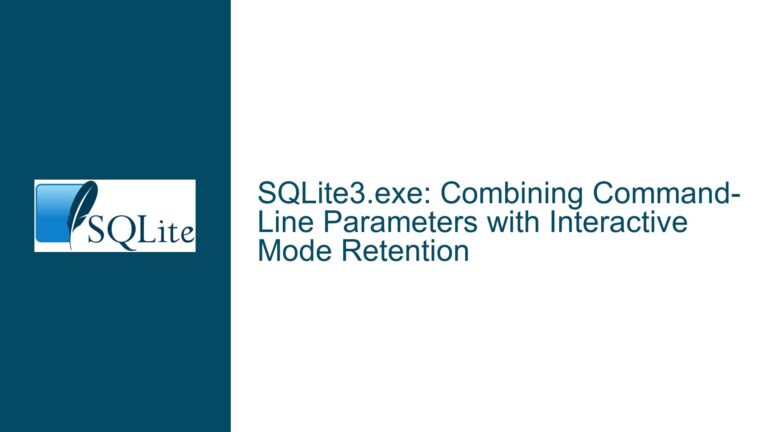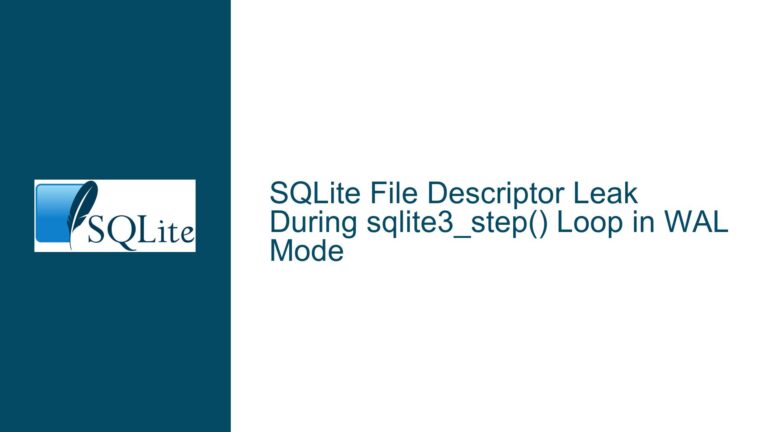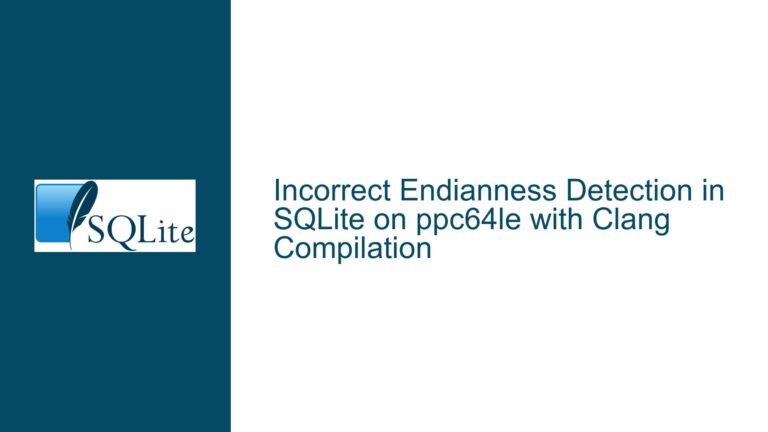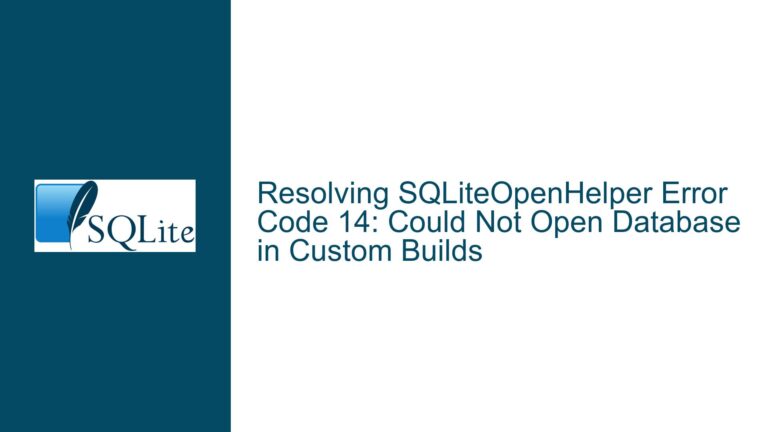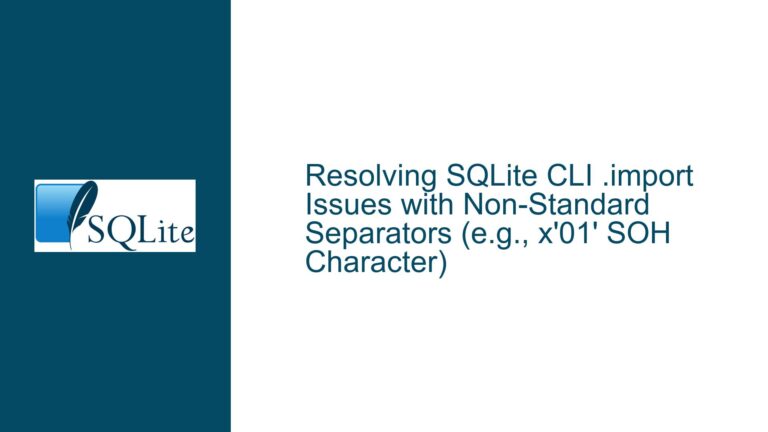SQLite Virtual Table Update-From Syntax Issues with Without Rowid Tables
SQLite Virtual Table Update-From Syntax and Without Rowid Tables
The SQLite UPDATE-FROM syntax introduced in version 3.33 provides a powerful way to perform updates by joining tables. However, when used with virtual tables declared as WITHOUT ROWID, certain issues arise, particularly around the handling of the xRowid and xUpdate methods. Virtual tables without rowids rely on primary keys for row identification, and the UPDATE-FROM syntax can trigger unexpected behavior, especially when the xRowid method is called despite the table being declared as WITHOUT ROWID. This issue is further complicated by the behavior of sqlite3_value_nochange and sqlite3_vtab_nochange during the update process.
The core problem manifests when the UPDATE-FROM statement attempts to access the rowid of a WITHOUT ROWID virtual table, leading to errors such as "Failed to get rowid: Tried to access rowid on a table that doesn’t have one." Additionally, the xUpdate method may not receive the expected arguments, particularly when sqlite3_value_nochange does not behave as anticipated. These issues highlight the need for careful handling of virtual table implementations, especially when dealing with WITHOUT ROWID tables and the UPDATE-FROM syntax.
Interrupted Write Operations and Incorrect xUpdate Arguments
The primary cause of the issue lies in the interaction between the UPDATE-FROM syntax and the virtual table’s xUpdate method. When a virtual table is declared as WITHOUT ROWID, SQLite should not call the xRowid method, as the table does not use rowids for row identification. However, in some cases, the UPDATE-FROM syntax triggers the xRowid method, leading to errors. This behavior suggests a bug in SQLite’s handling of WITHOUT ROWID virtual tables during UPDATE-FROM operations.
Another significant cause is the incorrect handling of sqlite3_value_nochange and sqlite3_vtab_nochange during the update process. The xUpdate method expects certain arguments to indicate which columns have been modified. However, when using the UPDATE-FROM syntax, sqlite3_value_nochange may not return the expected values, leading to incorrect behavior in the virtual table implementation. Specifically, columns that have not been modified may be incorrectly flagged as changed, causing the virtual table to process unnecessary updates.
The issue is further exacerbated by the query plan generated for the UPDATE-FROM statement. In some cases, SQLite may perform a full table scan instead of using an index, leading to inefficient query execution and incorrect behavior in the virtual table’s xColumn method. This behavior is influenced by the estimatedCost and estimatedRows values returned by the virtual table’s xBestIndex method. If these values are not set correctly, SQLite may choose a suboptimal query plan, leading to the observed issues.
Implementing Correct Query Plans and Handling sqlite3_vtab_nochange
To resolve these issues, several steps must be taken to ensure correct behavior when using the UPDATE-FROM syntax with WITHOUT ROWID virtual tables. First, the virtual table’s xBestIndex method must return appropriate values for estimatedCost and estimatedRows. Setting estimatedCost to 1 and estimatedRows to 1 when there is a usable constraint on the primary key ensures that SQLite uses an efficient query plan, avoiding full table scans. Additionally, the SQLITE_INDEX_SCAN_UNIQUE flag should be set in idxFlags to indicate that the query will return at most one row.
Next, the virtual table’s xUpdate method must be modified to handle cases where sqlite3_value_nochange does not return the expected values. Since sqlite3_vtab_nochange always returns false for UPDATE-FROM statements, the virtual table implementation should not rely on this function to determine whether a column has been modified. Instead, the virtual table should compare the old and new values of each column to determine whether an update is necessary. This approach ensures that the virtual table behaves correctly even when sqlite3_value_nochange does not provide accurate information.
Finally, the virtual table’s xColumn method should be updated to handle cases where sqlite3_vtab_nochange returns false. When this function returns false, the virtual table should provide the column value as usual, ensuring that the xUpdate method receives the correct arguments. By implementing these changes, the virtual table can handle UPDATE-FROM statements correctly, even when used with WITHOUT ROWID tables.
Detailed Steps for Troubleshooting and Fixing the Issue
Review the Virtual Table’s
xBestIndexMethod: Ensure that thexBestIndexmethod returns appropriate values forestimatedCostandestimatedRows. When there is a usable constraint on the primary key, setestimatedCostto 1,estimatedRowsto 1, andSQLITE_INDEX_SCAN_UNIQUEinidxFlags. This ensures that SQLite uses an efficient query plan, avoiding full table scans.Modify the Virtual Table’s
xUpdateMethod: Update thexUpdatemethod to handle cases wheresqlite3_value_nochangedoes not return the expected values. Compare the old and new values of each column to determine whether an update is necessary. This approach ensures that the virtual table behaves correctly even whensqlite3_value_nochangedoes not provide accurate information.Update the Virtual Table’s
xColumnMethod: Ensure that thexColumnmethod handles cases wheresqlite3_vtab_nochangereturns false. When this function returns false, the virtual table should provide the column value as usual, ensuring that thexUpdatemethod receives the correct arguments.Test the Virtual Table with
UPDATE-FROMStatements: After making the above changes, thoroughly test the virtual table withUPDATE-FROMstatements to ensure that it behaves correctly. Verify that thexRowidmethod is not called forWITHOUT ROWIDtables and that thexUpdatemethod receives the correct arguments.Review Other Virtual Table Implementations: If the virtual table implementation is used for multiple tables, review the other implementations to ensure that they also handle
UPDATE-FROMstatements correctly. Apply the same changes to these implementations to avoid similar issues.
By following these steps, you can ensure that your virtual table implementation handles UPDATE-FROM statements correctly, even when used with WITHOUT ROWID tables. This approach addresses the core issues and provides a robust solution for using the UPDATE-FROM syntax with virtual tables in SQLite.
Example Implementation
Below is an example of how to modify the xBestIndex, xUpdate, and xColumn methods to handle UPDATE-FROM statements correctly:
// Example xBestIndex method
static int vtBestIndex(sqlite3_vtab *pVTab, sqlite3_index_info *pIdxInfo) {
// Check for a usable constraint on the primary key
for (int i = 0; i < pIdxInfo->nConstraint; i++) {
if (pIdxInfo->aConstraint[i].usable && pIdxInfo->aConstraint[i].iColumn == 0) {
pIdxInfo->estimatedCost = 1.0;
pIdxInfo->estimatedRows = 1;
pIdxInfo->idxFlags = SQLITE_INDEX_SCAN_UNIQUE;
break;
}
}
return SQLITE_OK;
}
// Example xUpdate method
static int vtUpdate(sqlite3_vtab *pVTab, int argc, sqlite3_value **argv, sqlite3_int64 *pRowid) {
// Compare old and new values to determine if an update is necessary
if (argc > 1 && sqlite3_value_type(argv[0]) != SQLITE_NULL) {
// Perform the update
}
return SQLITE_OK;
}
// Example xColumn method
static int vtColumn(sqlite3_vtab_cursor *pCursor, sqlite3_context *ctx, int i) {
// Provide the column value as usual
sqlite3_result_text(ctx, "column_value", -1, SQLITE_TRANSIENT);
return SQLITE_OK;
}
By implementing these changes, you can ensure that your virtual table handles UPDATE-FROM statements correctly, even when used with WITHOUT ROWID tables. This approach addresses the core issues and provides a robust solution for using the UPDATE-FROM syntax with virtual tables in SQLite.

